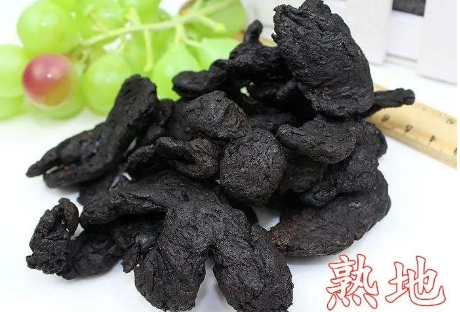
【Name】 Shú Dì Huáng (Rehmannia Glutinosa)
【Source】 From “Bencao Tujing”. “Bencao Tujing”: Dì Huáng, harvested in February and August, the roots are steamed for three to two days until soft, then dried in the sun, known as Shú Dì Huáng; the one dried in the shade is known as Shēng Dì Huáng.
【Pinyin】 Shú Dì Huáng
【Alias】 Shú Dì
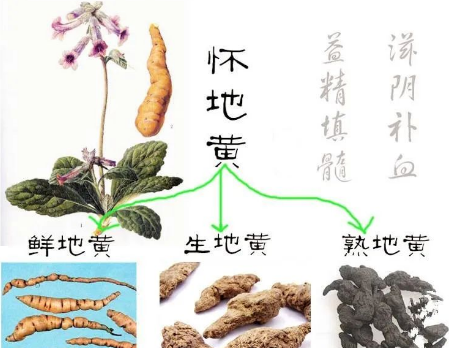
【Source of Medicinal Material】 The tuberous root of the plant Rehmannia glutinosa, processed by steaming and drying. Latin Name: Rehmannia glutinosa. Harvesting and Storage: Take dried Dì Huáng and add 30% Huangjiu (yellow wine), mix, and steam until it is black and shiny inside and out, then dry. Alternatively, steam dried Dì Huáng in a steamer for 8 hours, let it rest overnight, then flip it over, steam for another 4-8 hours, let it rest overnight, take it out, dry until 80% dry, slice, and then dry completely.
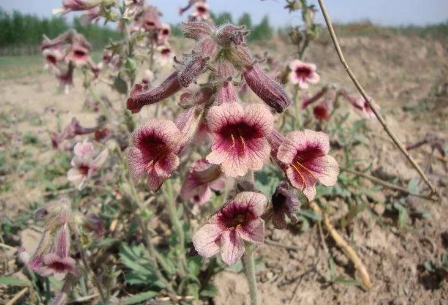
【Morphology】 Dì Huáng is a perennial herb, 10-40 cm tall. The whole plant is covered with grayish-white long hairs and glandular hairs. The roots are thick, fleshy, tuberous, cylindrical or spindle-shaped. The stem is erect, single or branched at the base. The basal leaves are clustered, ovate-lanceolate, 3-10 cm long, 1.5-4 cm wide, blunt at the tip, gradually narrowing at the base, extending into long petioles, with a wrinkled surface and irregular serrated edges; the stem leaves are smaller. The flower stalk is erect, hairy, with a raceme at the upper part of the stem; the bracts are leaf-like, well-developed or degenerated.
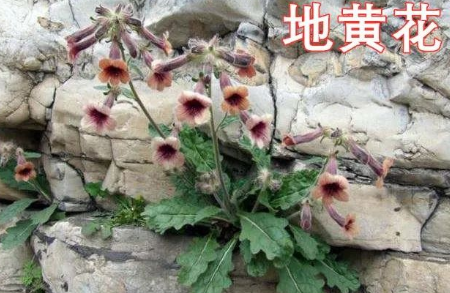
The flower calyx is bell-shaped, with 5 lobes at the tip, the lobes are triangular, covered with multicellular long hairs and white long hairs, with 10 veins; the corolla is wide tubular, slightly curved, 3-4 cm long, dark purple outside, mixed with yellow inside, with distinct purple stripes, the tip is shallowly lobed, slightly bilabiate; there are 4 stamens, two strong, the anthers are forked at the base; the ovary is superior, oval, 2-celled, becoming 1-celled after flowering, with 1 style and a swollen stigma. The capsule is oval or long oval, pointed at the tip, with a persistent style, surrounded by the persistent calyx. The seeds are numerous. The flowering period is from April to May, and the fruiting period is from May to June.
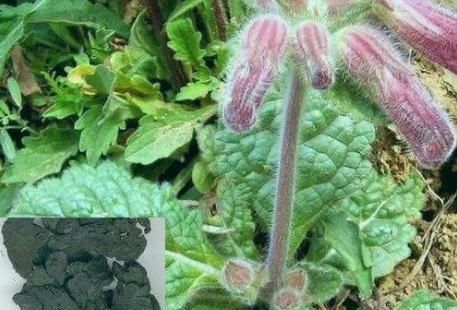
【Preparation Method】 Take dried Dì Huáng and add 30% Huangjiu, mix, and steam until it is black and shiny inside and out, then dry. Alternatively, steam dried Dì Huáng in a steamer for 8 hours, let it rest overnight, then flip it over, steam for another 4-8 hours, let it rest overnight, take it out, dry until 80% dry, slice, and then dry completely.
① From “Leigong Paozhi Lun”: “Harvest Shēng Dì Huáng, remove the white skin, steam it in a willow wood steamer, spread it out to let the steam escape, mix with wine and steam again, then dry. Do not use copper or iron utensils.”
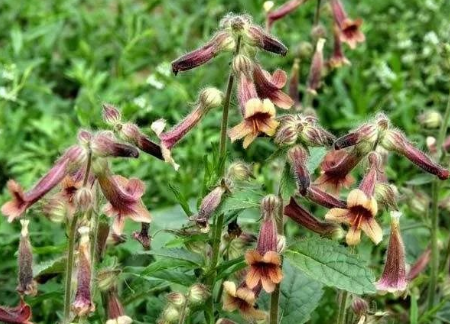
② From “Bencao Tujing”: “Take 30-20 jin of fat Dì Huáng, wash it clean, remove the thin roots and short roots, also obtain 20-30 jin, pound and squeeze to extract the juice, put it in silver or copper utensils, soak the fat Dì Huáng in the juice, steam it for three or four times, soaking and turning it each time, after steaming, dry it in the sun until the juice is completely gone, the Dì Huáng should be shiny black like lacquer, sweet like syrup. It must be collected in a pot to keep its fat soft and moist.”
③ From “Gangmu”: “Recently, the method is to select heavy, fat ones, add good wine and sand ginger powder inside, mix well, steam in a willow wood steamer in a clay pot until the steam penetrates, dry, then mix with sand ginger wine and steam again, repeating this nine times. Dì Huáng is muddy in nature, and it absorbs the fragrance of sand ginger, harmonizing the qi of the five organs and returning to the dantian. Nowadays, those sold in the market are only boiled in wine, which is not suitable for use.”
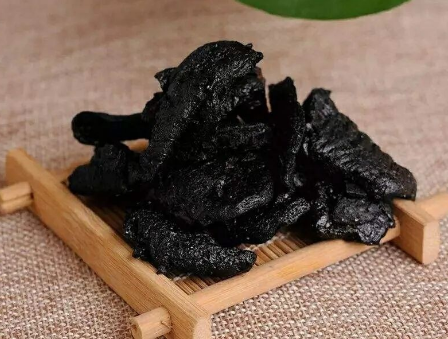
【Properties】 Irregular block shape, black inside and out, with a wrinkled and uneven surface. Soft texture, moist cross-section, often with shiny, oily blocks visible in the center, very sticky. Sweet taste.
【Processing】 Shú Dì Huáng Charcoal: Take Shú Dì Huáng and place it in a calcining pot, fill it to 80%, cover with another pot, seal the joint with yellow clay, press down with a heavy object, and calcine with gentle and strong fire until the white paper stuck to the bottom of the lid turns yellowish brown, block the fire door, wait for it to cool, then take it out; alternatively, directly fry Shú Dì Huáng in the pot until charred.
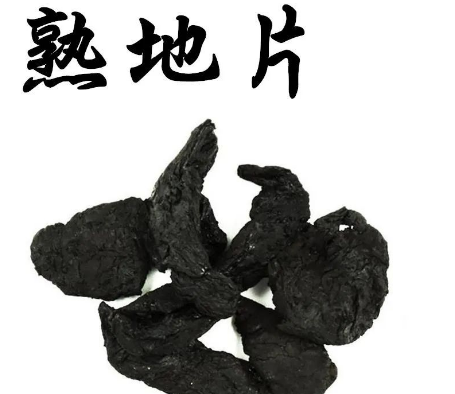
【Taste and Properties】 Sweet, slightly warm.
① From “Zhenzhu Nang”: “Sweet and bitter.”
② From “Gangmu”: “Sweet, slightly bitter, slightly warm.”
③ From “Bencao Xinbian”: “Sweet taste, warm nature.”
【Meridians Entered】 Enters the Liver and Kidney meridians.
① Li Gao: “Enters the hand and foot Shaoyin and Jueyin meridians.”
② From “Bencao Congxin”: “Enters the foot’s three Yin meridians.”
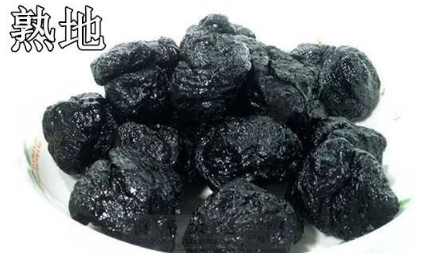
【Functions】 Nourishes Yin, replenishes blood. Treats Yin deficiency with low blood, weakness in the waist and knees, cough with bone steaming, nocturnal emissions, metrorrhagia, irregular menstruation, diabetes, frequent urination, deafness, and dim vision.
① From “Zhenzhu Nang”: “Greatly replenishes blood deficiency, opens blood vessels, and benefits qi and strength.”
② Wang Haogu: “Mainly for those who want to rise but cannot, with eyes that see nothing.”
③ From “Gangmu”: “Fills the bone marrow, promotes muscle growth, generates essence and blood, nourishes the five organs, treats internal injuries, opens blood vessels, benefits the ears, darkens hair, treats the five labor and seven injuries in men, and various diseases in women related to menstruation and childbirth.”
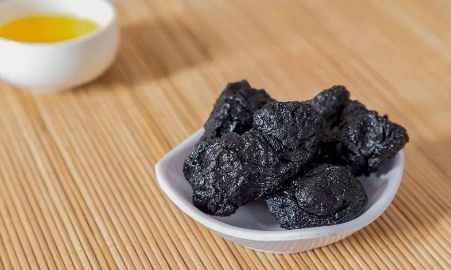
④ From “Bencao Congxin”: “Nourishes kidney water, fills bone marrow, benefits blood vessels, nourishes true Yin, sharpens hearing and vision, darkens hair. Also nourishes spleen Yin, stops chronic diarrhea, treats labor injuries, wind and cold bi syndrome, Yin deficiency with fever, dry cough with phlegm, shortness of breath, feeling empty in the stomach, post-illness leg and thigh pain, postpartum abdominal pain, and various blood-related issues, all liver and kidney Yin deficiencies, and various diseases due to deficiency, being the main medicine for nourishing water.” (Effects and Functions of Shú Dì Huáng)
【Cautions】 Avoid use in cases of spleen and stomach deficiency, qi stagnation with phlegm, abdominal fullness, and loose stools.
① From “Leigong Paozhi Lun”: “Do not use with steel or iron utensils, as it can cause kidney depletion and white beard hair, damaging the essence and defense.”
② From “Pinhui Jingyao”: “Avoid radishes, scallions, leeks, and garlic.”
③ From “Yixue Rumeng”: “Use cautiously in cases of fullness and phlegm.”
④ From “Bencao Congxin”: “For those with qi stagnation, it can obstruct the chest and diaphragm, use with caution.”
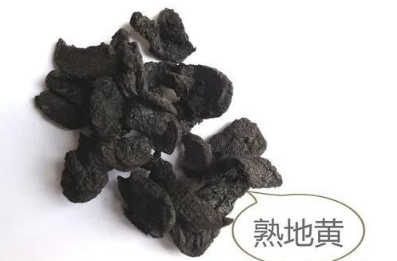
【Additional Formulas】
① For treating male and female blood deficiency, insufficient nourishment: 8 liang of Shú Dì (take the sweetest, dry to remove moisture), 1 qian of sandalwood (or 3 qian of white sandalwood), 4 liang of goji berries (use the fattest, dry to remove moisture). Each herb is 1 jin, soak in 10 jin of high-quality liquor, no need to cook, just soak for ten days, then it can be used. Those who take this should not drink excessively, after finishing, add another 6-7 jin of liquor, soak for another half month, and it can still be used. (From “Jingyue Quanshu” Dì Huáng Li)
② For treating various deficiencies, abdominal and flank pain, blood loss with low energy, lack of appetite, fever, and women’s menstrual issues: Shú Dì (sliced and baked), and Dang Gui (remove the sprouts, sliced and baked) in equal parts. Grind into a fine powder, mix with honey to form pills the size of a walnut, take 20-30 pills before meals with warm water. (From “Jifeng Pujifang” Wanbing Wan)
③ For treating mutism, kidney deficiency, and inability to speak: Shú Dì, Ba Jiao (remove the heart), Shan Zhu Yu, Shi Hu, Rou Cong Rong (soaked in wine and baked), Fu Zi (processed), Wu Wei Zi, Gong Gui, Bai Fu Ling (remove the skin), Mai Men Dong (remove the heart), Chang Pu, Yuan Zhi (remove the heart) in equal parts. Grind into a powder, take 3 qian with 1.5 cups of water, 5 slices of ginger, 1 jujube, and mint, decoct until 80% remains, regardless of time. (From “Xuanming Lunfang” Dì Huáng Yin Zi)
④ For treating bone steaming, body heat, and fatigue: Rehmannia, Dang Gui, Dì Guo Pi, Zhi Ke (fried with bran), Chai Hu, Qin Jiao, Zhi Mu, Bie Jia (roasted) in equal parts. Grind into a powder, take with 1 cup of water and half a dried plum, decoct until 70% remains, take warm. (From “Youyou Xinshu” Dì Huáng San)
⑤ For regulating and nourishing qi and blood, treating deficiency of Chong and Ren, menstrual irregularities, abdominal pain, metrorrhagia, blood clots, pain during menstruation, pregnancy complications, and postpartum issues: Dang Gui (remove the reed, soaked in wine and roasted), Chuan Xiong, Bai Shao, Shú Dì (soaked in wine and steamed) in equal parts. Grind into a coarse powder, take 3 qian with 1.5 cups of water, decoct until 80% remains, remove the dregs and take warm before meals. (From “Jufang” Si Wu Decoction)

⑥ For treating frequent urination: 1 liang of Long Gu, 1 liang of Sang Piao Xiao, 1 liang of Shú Dì, 1 liang of Gua Lou Gen, and 1 liang of Huang Lian (remove the beard). Grind into a fine powder, take 2 qian before meals with congee. (From “Shenghui Fang”)
⑦ For treating children’s kidney deficiency, inability to speak, and developmental issues: 8 qian of Shú Dì, 4 qian each of Shan Yu Rou and Gan Shan Yao, and 3 qian each of Ze Xie, Mu Dan Pi, and Bai Fu Ling (remove the skin). Grind into a powder, mix with honey to form pills the size of a walnut, take 3 pills with warm water on an empty stomach. (From “Children’s Medicine Directives” Dì Huáng Wan)
⑧ For treating shortness of breath, rapid breathing, and severe cases: 7-8 qian of Shú Dì, or 1-2 liang for severe cases, 2-3 qian of roasted licorice, and 2-3 qian of Dang Gui. Use 2 cups of water, decoct until 80% remains, take warm. (From “Jingyue Quanshu” Zhenyuan Drink)
⑨ For treating water deficiency and excessive heat, floating and slippery pulse, insufficient Shaoyin, and excess Yangming, with symptoms of irritability, dry thirst, headaches, toothaches, and blood loss: 3-5 qian of Sheng Shi Gao, 3-5 qian or 1 liang of Shú Dì, 2 qian of Mai Dong, and 0.5 qian each of Zhi Mu and Niu Xi. Use 1.5 cups of water, decoct until 70% remains, take warm or cold. If there is loose stool, it is not suitable. (From “Jingyue Quanshu” Yunu Decoction)
⑩ For treating liver Qi invading the stomach, pain in the stomach and heart, flank pain, acid reflux, vomiting, hernia, and all liver diseases: Bei Sha Shen, Mai Dong, Dì Huáng, Dang Gui, Goji Berries, and Chuan Lian. (From “Liuzhou Medical Talk” Yiguang Decoction)
The above content is extracted from the internet, with gratitude to the original author!



